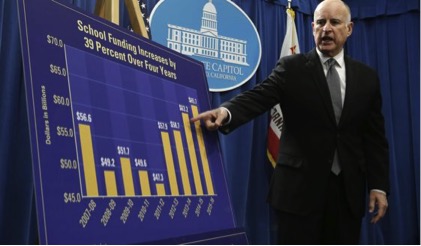California: Save Now, Spend Later
Not too long ago, California was facing historically high unemployment rates and a multi-billion dollar deficit. Today, California faces another fiscal issue—an embarrassment of riches. California’s current $8 billion budget surplus is expected to stir competition amongst various special interests groups that hope to be on the receiving end as they lobby for funding from the State. This surplus, however, does not mean that all is well in California, but it is indicative that we are on the road to recovery from one of the worst recessions the state has ever seen.
In 2003, California was hit with the harsh reality that there was a shortfall of cash under former Governor Gray Davis. This deficit would grow during Arnold Schwarzenegger's tenure as Governor. In 2008, Governor Schwarzenegger cut back state spending and decreased workdays for millions of teachers, eliminating paid holidays and altering overtime pay regulations to save money. The 2009 budget featured service cuts, education cuts, and layoffs at CSU’s and UC’s, as well as an added furlough day each month for all state workers.
The Great Recession significantly affected California; teachers across the state feared layoff daily, while other state workers suffered from salary cuts and unpaid furlough days. According to the California Budget and Policy Center, California ranked 42nd in K-12 school spending in 2013. California has since narrowed the gap between the state’s K-12 spending relative to the state economy, but the state still ranks below the national average.
In 2012, under current Governor Jerry Brown, California began to see a surplus in the state budget after the passage of Proposition 30. The proposition temporarily increased taxes for California’s wealthiest while also slightly increasing the sales tax to produce funds for the state’s public education system. Proposition 30 will generate upwards of $12 billion in the upcoming two years as the tax increases phase out.
The San Jose Mercury News reports that California’s eight billion dollar surplus exceeds expectations by the billions, which may come as a surprise to many. However, the majority of this money has already been earmarked under Proposition 98, which was enacted in 1988 and requires a minimum percentage of the state budgets to be spent in the K-12 public education system. The majority of the eight billion dollars will be allocated to K-12 schools.
Another large portion of the surplus will be allocated to the rainy day fund after voters approved Proposition 2 during November’s election. The Rainy Day Budget Stabilization Fund Act requires the state to make changes to the requirement for the Budget Stabilization Account, and establishes a Public School System Stabilization Account. Estimates say that this would leave about one billion dollars in surplus to spend.
The state legislature has various ideas of how to spend the money, but nothing will be conclusive until Governor Brown unveils his budgets revisions and the state releases the finalized estimates of the surplus. Speaker of the Assembly Toni Atkins (D-San Diego) hopes to increase the per-student spending ratio, increase access to childcare, and expand preschool programs across the state. Additionally, she hopes to see the money fund the UC and CSU education systems, but with several conditions: a freeze in current tuition cost, a decrease in out-of-state student enrolment, pension reform for employees, and a cut in administrative cuts. As necessary as this may be, it is quite a tall order that will require time and an upheaval of the current system in place.
On the Senate side, California President Pro Tempore Kevin de Leon (D-Los Angeles) has proposed the elimination of the Middle Class Scholarship to provide more funds to the UC and CSU systems, a plan that the state assembly will not support. Additionally, de Leon hopes to develop the CalWorks program to benefit low-income children and mothers. Unfortunately, the state legislature is asking the wrong question. State legislators should be asking themselves whether it is necessary to spend the money at all, rather than how to spend it all.
There will be many interest groups lobbying for an increase of funding at the governor's office before the May revisions of the 2015-2016 budget are released and take effect later this year. Some will lobby for tax reform, while others for increased funding in education, healthcare or welfare; however, I was always taught to never spend my money just because I have it. The state is not obligated to spend the funds just because there is a surplus of roughly one billion dollars. The state should instead allocate the money to the rainy day fund.
California is currently dealing with many issues, and these issues will continue to be there in the coming year. Governor Brown has also committed to several projects including the California high-speed rail project and the proposed twin tunnels that would divert water from the Sacramento River and San Francisco Delta to aid the San Joaquin Valley. These projects, however, are very costly. Additionally, California is in its fourth year of a drought that has led to water restrictions throughout the state and has left some cities dry.
Thus, placing $1 billion in the piggy bank is the right choice. The economy may falter at any minute, and as the drought worsens with no end in sight it is crucial for California to save money for when it is truly needed. If I found myself with an extra $1 billion, I would want to spend it right away. But to avoid reliving the Great Recession, it is necessary for California to be wise and save its money.

